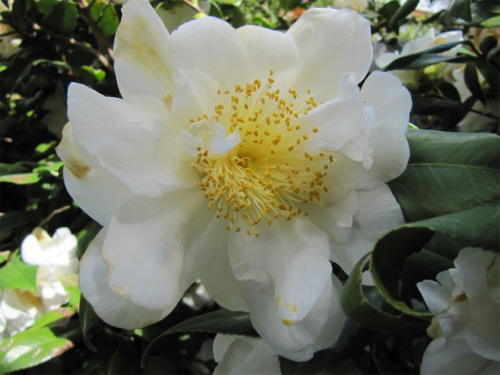
THE camellia family is one of the most rewarding of ornamental plants.

We had Camellia sasanquas flowering all winter and, as they fade, flowers are appearing on the larger-leafed Camellia japonicas.
The main difference in growing these beautiful plants in Canberra is the small-leafed sasanqua will grow happily in full sun but japonicas need some shade.
I have them growing on the south side of our home and a big plus for japonica is to be able to grow some magnificent white specimens, whereas the sasanqua’s white flowers easily brown off with frosts in our winters.
Camellias have a long history and while it is unclear if japonicas originated in Japan or China, they appeared in Chinese paintings from the 11th century and later as decorative motifs on porcelain.
It is claimed there are japonicas in China 10 metres tall and more than 600 years old.
Every time you sip a cup of tea, the leaves are from Camellia sinensis and while its origin is uncertain, tea drinking in China became popular in the 6th and 7th centuries. Sinensis is not widely grown as a garden ornamental mainly due to the insignificant white flowers, but makes a good conversation piece.
With camellia societies around the world, there are now more than 30,000 named cultivars and increasing all the time.
Despite the delicacy of the flowers, camellias are extremely hardy and resistant. They can be pruned really hard after flowering and will bounce back with new growth very quickly. For example, they can be reduced from three metres tall down to one metre with no ill effects.

One breeder of international significance was the late Prof Eben Gowrie Waterhouse with his garden “Eryldene” at Gordon in Sydney. He bred many new cultivars and his historic home and garden are open to the public. His fascinating story can be found at eryldene.org.au

I ALWAYS recommend planting marigolds around the veggie patch to keep insects away and now a report in “Country Life” magazine says researchers from Newcastle University in the UK have confirmed the scientific reason behind this ancient gardening folklore is that marigolds repel tomato whiteflies. Limonene is naturally produced by marigolds, which repel whitefly without doing any harm to veggie plants or other beneficial insects.
This discovery is far less risky than using chemicals to achieve the same effect. Growing marigolds in the general garden besides the veggie patch provides nectar for bees essential for pollination.

IN the same magazine Alan Titchmarsh, for many years the very popular presenter of BBC TV’s “Gardener’s World”, writes on the increasing interest in growing Australian native plants in the UK. He is growing a Grevillea robusta in his glasshouse and I can only hope he has a very tall glasshouse. There is an ever expanding interest in our native plants also in Holland. I thought I would show you a plant label from the Intratuin Garden Centre at Halsteren in Holland.
ANOTHER word for pruning is stimulation, promoting new and increased growth for more flowers and, in the case of fruit trees and vines, more fruit. If you are pruning or taking remedial action on deciduous trees the rule is to never prune between now and October 21. This is when the sap is rising and will simply pour out, inhibiting the healing of the wounds. This is particularly noticeable on silver birches.
Who can be trusted?
In a world of spin and confusion, there’s never been a more important time to support independent journalism in Canberra.
If you trust our work online and want to enforce the power of independent voices, I invite you to make a small contribution.
Every dollar of support is invested back into our journalism to help keep citynews.com.au strong and free.
Thank you,
Ian Meikle, editor




Leave a Reply